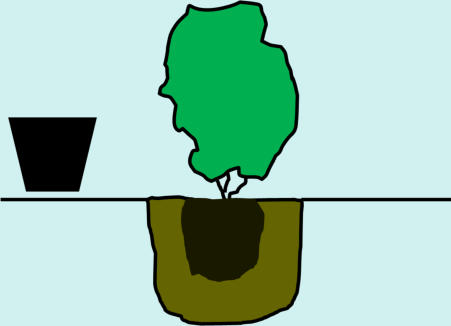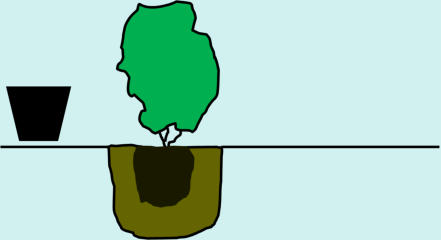
© Garden Cottage Nursery, 2022

Planting Plans
Windbreaks and Hedges

A simple layout for planting a coastal hedge with an optional second layer offset to the first, this will give you a thicker hedge
quicker, but take twice the number of plants.
Plant at least 1m back from your boundary fence to allow clipping of the front face. Most good coastal hedging varieties like
Escallonia rubra ‘Crimson Spire’ or Olearia macrodonta ‘Major’ will form a good dense hedge with a planting spacing of 1m
centres.
Though a bit pricey (a 1x50m roll costs approx. £50) attaching good quality nylon mono-filament windbreak netting to the front of
the fence will give the young shrubs a nice bit of extra protection until they are established.

Two effective coastal windbreak layouts: On the left two rows of stout shrubs to protect the young trees that will grow up behind.
To the right the trees are straddled by rows of shrubs.
A 2m spacing for the trees is fine when they are young to give extra protection to each other and in their lee and as insurance for
losses. In time however, as they get bigger, they will need thinned, likely removing every other one to allow the remaining to grow
out broader and less spindly.

An effective planting method is to dig
a hole for each plant individually
rather than a trench. Dig a hole,
rocks allowing, twice as deep and
wide as the plant’s pot. Mix in a
small amount of fish, blood and bone
(a well balanced organic, i.e. not
mineral based, slow release fertiliser)
to the spoil pile.

Now loosen the roots around the edge of the plant’s rootball.
Push the spoil backing to the hole with the plant at it’s centre,
firming the soil around the shrub, ending up with everything
flush with the existing ground level. Digging the hole bigger
than the plant’s rootball gives the plant a less compacted and
rock filled area to grow into so it will establish quicker.
You can top-dress with a piece of old carpet cut into a circle
with a slice cut to the centre and placed around the base, this
will suppress weeds and reduce water loss over summer.
A cheap and easy, if a bit smelly top dressing is to collect
some seaweed from the shore, slightly older stuff, preferably
from spring tides so some of the salt has washed out, and lay
it around the plant 2-3” thick. The top will dry to crust and keep
the soil beneath moist in summer and slowly feed the plant as
the seaweed rots down.
In exposed coastal gardens trees will find it difficult to
establish, always plant them young and provide
protection from the wind, but avoid tree tubes as trees
are too soft inside the tube and will struggle to emerge
from the top.
When staking place a stout stake at 45 degrees to the
ground, pointing away from the prevailing wind and
attached to the tree via a spacer near the base. The
rootball should remain steady but the canopy can still
flex and toughen. Check stakes at least annually and
remove them as soon as no longer needed.







Hedges

Windbreaks
Stage 1

Stage 2
Staking



© Garden Cottage Nursery, 2021

Planting Plans
Windbreaks
and Hedges


A
simple
layout
for
planting
a
coastal
hedge
with
an
optional
second
layer
offset
to
the
first,
this
will
give
you
a
thicker
hedge
quicker, but take twice the number of plants.
Plant
at
least
1m
back
from
your
boundary
fence
to
allow
clipping
of
the
front
face.
Most
good
coastal
hedging
varieties
like
Escallonia
rubra
‘Crimson
Spire’
or
Olearia
macrodonta
‘Major’
will
form
a
good
dense
hedge
with
a
planting
spacing
of
1m centres.
Though
a
bit
pricey
(1x50m
roll
costs
approx
£50)
attaching
good
quality
nylon
monofilament
windbreak
netting
to
the
front
of
the
fence
will
give
the
young
shrubs
a
nice
bit
of
extra
protection until they are established.


Two
effective
coastal
windbreak
layouts:
Above,
two
rows
of
stout shrubs to protect the young trees that will grow up behind.
Below, the trees are straddled by rows of shrubs.
A
2m
spacing
for
the
trees
is
fine
when
they
are
young
to
give
extra
protection
to
each
other
and
in
their
lee
and
as
insurance
for
losses.
However
in
time,
as
they
get
bigger,
they
will
need
thinned,
likely
removing
every
other
one
to
allow
the
remaining
to grow broader and less spindly.


An effective planting method is to dig a hole for each plant
individually rather than a trench. Dig a hole, rocks allowing,
twice as deep and wide as the plant’s pot. Mix in a small
amount of fish, blood and bone (a well balanced organic, i.e. not
mineral based, slow release fertiliser) to the spoil pile.

Now loosen the roots around the edge of the plant’s rootball.
Push the spoil backing to the hole with the plant at it’s centre,
firming the soil around the shrub, ending up with everything flush
with the existing ground level. Digging the hole bigger than the
plant’s rootball gives the plant a less compacted and rock filled
area to grow into so it will establish quicker.
You can top-dress with a piece of old carpet cut into a circle with
a slice cut to the centre and placed around the base, this will
suppress weeds and reduce water loss over summer.
A cheap and easy, if a bit smelly top dressing is to collect some
seaweed from the shore, slightly older stuff, preferably from
spring tides so some of the salt has washed out, and lay it
around the plant 2-3” thick. The top will dry to crust and keep the
soil beneath moist in summer and slowly feed the plant as the
seaweed rots down.
In exposed coastal gardens trees will
find it difficult to establish, always plant
them young and provide protection from the
wind, but avoid tree tubes as trees are too soft
inside the tube and struggle to emerge from the top.
When
staking
place
a
stout
stake
at
45
degrees
to
the
ground,
pointing
away
from
the
prevailing
wind
and
attached
to
the
tree
via
a
spacer
near
the
base.
The
rootball
should
remain
steady
but
the
canopy
can
still
flex
and
toughen.
Check
stakes
at
least
annually and remove them as soon as no longer needed.
























